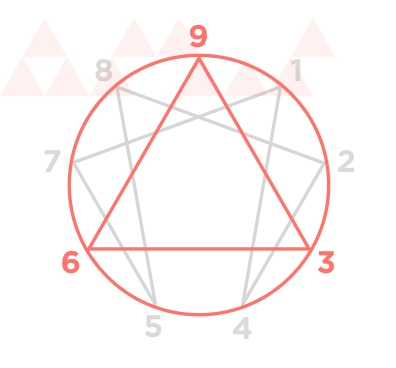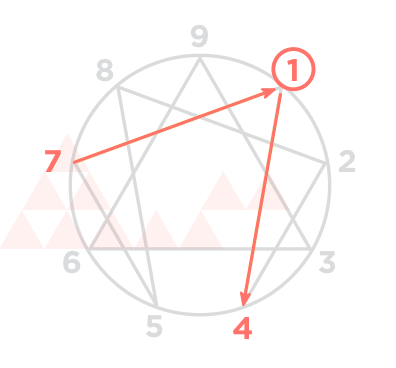What Is the Enneagram of Personality?
The Enneagram is a system of personality typing that describes patterns in how people interpret the world and manage their emotions. There are nine Enneagram Personality Types, each of which has their own key motivations and fears that largely guide their actions and decisions. Understanding your primary type can be a powerful tool for self knowledge and improvement in all areas of your life, both at home and in the workplace.
What is an Enneagram: Definition and Meaning
The Enneagram is a system of personality typing that describes patterns in how people interpret the world and manage their emotions. The Enneagram describes nine personality types and maps each of these types on a nine-pointed diagram which helps to illustrate how the types relate to one another.
The name Enneagram comes from the Greek: Ennea is the Greek word for nine and Gramma means something that’s drawn or written.
To find your Enneagram type, take the free enneagram test.
What Does the Enneagram Tell Us?
According to the Enneagram, each of the nine personality types is defined by a particular core belief about how the world works. This core belief drives your deepest motivations and fears — and fundamentally shapes a person's worldview and the perspective through which they see the world and the people around them.
Our core beliefs are not necessarily incorrect, but they can be limiting and operate as “blinders” for people. Understanding our Enneagram type and how it colors our perceptions can help us to broaden our perspective and approach situations more effectively.
Understanding a person's Enneagram type helps us to see why they behave the way they do. Each Enneagram type has a set of core beliefs that will consistently motivate them to take particular actions and guide them to make certain decisions. Behavior that may seem confusing or contradictory can often be explained when we understand a person's Enneagram type.
The Enneagram also helps us understand how people react to stress. By describing how each Enneatype adapts and responds to both stressful and supportive situations, the Enneagram shows opportunities for personal development and provides a foundation for the understanding of others.
How the Enneagram Works
As each person grows into adulthood, they will find their motives and fears dominated by one of the nine Enneagram personality types. Your basic type is largely influenced by biological factors, but is also impacted by your environmental influences growing up — such as family dynamics or parental relationships.
The Enneagram uses a numbers system to designate each type. As it is a horizontal system of growth, no one number is better than another. Individuals may relate to more than one type, but the general opinion is that people do not change from one Enneagram personality to another. Rather, they resonate with different traits depending on their overall levels of health.
Each of the nine types have their own key motivations and fears that largely guide their actions and decisions. Read more about each of the 9 Enneagram types.
Understanding the Enneagram Symbol
The basis of the Enneagram is a nine-pointed geometric symbol. It consists of an outer circle, on which the nine points (personalities) are numbered clockwise and evenly spaced.

There is also a triangle between the points 9, 3 and 6 and an irregular hexagon which connects the other points. The circle represents the wholeness and unity of human life while the other shapes represent how it is divided.
Wings in the Enneagram
“Wings” is the term given to the two Enneagram types found on either side of your core type. For example, a Nine’s wings are Eight and One, a Seven’s wings are Six and Eight, and a Four's wings are Three and Five. Enneagram wings represent related personality styles which we can transition into, in order to develop new facets of ourselves.

Some people refer to wings as a subtype (i.e., “I’m a 4w3”). However, most modern practitioners take issue with using wings in this way. While we may resonate more with one wing or another, both offer opportunities for growth. When we shift from seeing wings as part of “our type” to seeing them as opportunities for growth, we open up greater possibilities for ourselves.
When using wings for growth, look at the characteristics of the type behind you first before the type ahead of you (for example, if you’re a Three, you would look to Two first and then Four). Learning to integrate characteristics from both types into your personality will help you become more well-rounded and effectively handle problems.
Many people identify strongly with the description of one or both of their wings, in addition to their primary type. Understanding the influence of the Enneagram wings can help to add more nuance to one's understanding of themselves.
Arrows in the Enneagram
Each basic type in the Enneagram is also connected by two lines to two other basic types. Each line has an arrowhead on it, one pointing towards the primary type and one pointing away.
Arrows represent the aspects of our personality that we need to develop to become more whole and balance out the limitations of our core type. The first line, pointing toward the core type, connects to the type which the person has left behind or repressed in childhood; the characteristics of this type must be re-integrated for the person to develop. This is called the “against” arrow.
The second line, pointing away from the core type, connects to the type which the person may grow into once they are ready to reach a higher state of development. This is called the “forward arrow.” In the example below, you can see that for a Type One, the “against” arrow moves from Seven to One and the “forward” arrow moves from One to Four.

We can also think of arrows as where we go when we feel secure or under stress. Using the example above, the One will move toward Seven when they feel secure, acting more playful and spontaneous. The One will move toward Four under stress, and may be more moody and self-conscious.
These connecting lines highlight how each basic type possesses indispensable strengths, but at the same time has darker sides that are full of challenges. The inclusion of these lines moves the Enneagram from a purely descriptive personality model to one that is dynamic, showing how personality can change under different conditions.
Want to dive even deeper into the Enneagram? Read about Enneagram Defenses, Passions and Fixations.
History of the Enneagram
We don’t know the exact origin of the Enneagram, but we do know it has an eclectic history. Some assume ancient roots in Babylon around 4,500 years ago while others place the origin in classical Greek philosophy around 2,500 years ago.
The model has been attributed to the Jewish Kabbalah, Christian mysticism and Sufism, a mystical form of Islam. In fact, it has been posited that Dante apparently had very good knowledge of the Enneagram since the characters in The Divine Comedy correspond largely to the Enneagram types!
What we do know is that the modern Enneagram system is the work of contemporary authors. Georg Ivanovich Gurdjieff, a mystic and spiritual teacher, introduced the model as a spiritual symbol in the 1930s, and it arrived on American shores in the 1960s.
Other notable 20th century teachers of the Enneagram are Oscar Ichazo and Claudio Naranjo. Naranjo, a Chilean psychiatrist, learned of the Enneagram through Ichazo’s work and is most well-known for introducing the Enneagram into the field of modern-day psychology. The system was later introduced to several religious and spiritual communities throughout the United States.
Most researchers today tend to focus on the psychological rather than the religious side of the Enneagram, drawing comparisons with other personality models like the Myers-Briggs system.
Applications of the Enneagram
The Enneagram is mostly used for self-knowledge and personality development, offering a powerful tool for better understanding your core motivations and applying that knowledge to all areas of your life, including conflict resolution, team dynamics, leadership and emotional intelligence.
Because it identifies opportunities for development for each individual type, it has become widely used in areas such as counseling, psychotherapy, business development, parenting and education.
The system has been the inspiration for multiple Enneagram personality tests as well as books on an eclectic variety of subjects, from personal development and spiritual growth, to relationships and career development.